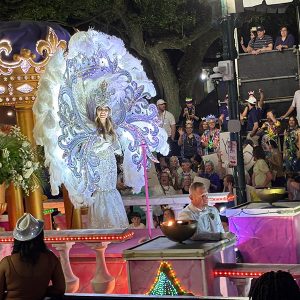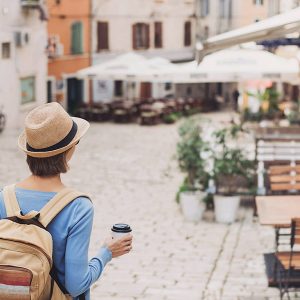Eastern Crete
If you like your islands on the monumental and dramatic side, you have to visit Crete. This is a very mountainous island – and these are serious mountains. The highest peaks are some 2456m high. That’s almost twice as high as Ben Nevis. Even in late spring you can see a sprinkling of snow on the tops. The summer season, though, is not just hot, it’s unusually long, thanks to Crete’s position. It’s one of the southernmost islands in the Mediterranean.
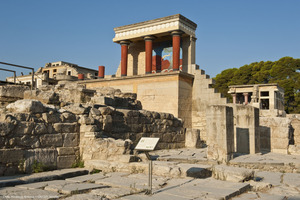 And yet, Crete is not one of those islands in the Med that is overwhelmed by tourists in the season. Perhaps its sheer size means you always have a sense of space – as long as you avoid the obvious hotspots. There is one hotspot, though, that there’s simply no avoiding. You absolutely must go to Knossos. The Palace of Knossos was the centrepiece of Minoan Crete, a civilisation both ancient (the first palace was built around 2000BC) and unique. This is a people who left behind no weapons (except for ceremonial ones) and whose towns and palaces were entirely unfortified. There is much evidence that they had a great love of gardens and nature, were considerable artists, revered beauty and treated men and women equally. So a society quite unlike any other in the ancient world.
And yet, Crete is not one of those islands in the Med that is overwhelmed by tourists in the season. Perhaps its sheer size means you always have a sense of space – as long as you avoid the obvious hotspots. There is one hotspot, though, that there’s simply no avoiding. You absolutely must go to Knossos. The Palace of Knossos was the centrepiece of Minoan Crete, a civilisation both ancient (the first palace was built around 2000BC) and unique. This is a people who left behind no weapons (except for ceremonial ones) and whose towns and palaces were entirely unfortified. There is much evidence that they had a great love of gardens and nature, were considerable artists, revered beauty and treated men and women equally. So a society quite unlike any other in the ancient world.
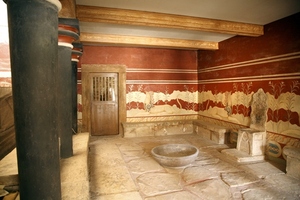 Knossos is always going to be busy, though, so if you can the best time to go is out of season and either early in the morning or towards the end of the day. The marvellous wall paintings are reproductions and the originals are in Heraklion Museum along with many extraordinary Minoan artefacts – well worth a visit. However, the reproductions and the restoration work done by Arthur Evans at the very start of the twentieth century do give a very real sense of what this palace (and indeed town) was like, even if his rebuilding efforts are rather frowned on nowadays.
Knossos is always going to be busy, though, so if you can the best time to go is out of season and either early in the morning or towards the end of the day. The marvellous wall paintings are reproductions and the originals are in Heraklion Museum along with many extraordinary Minoan artefacts – well worth a visit. However, the reproductions and the restoration work done by Arthur Evans at the very start of the twentieth century do give a very real sense of what this palace (and indeed town) was like, even if his rebuilding efforts are rather frowned on nowadays.
Knossos was the mythical home of King Minos and the setting for the story of Theseus and the Minotaur. You can readily see where the idea of the labyrinth came from – Knossos is a maze with lots of different levels and more than a thousand rooms. The Minotaur itself was no doubt based on the Minoan love of bull leaping – teams of young men and women who vaulted like acrobats over the backs of a bull. Legend has it that it was the great craftsman Daedalus who created the maze to contain the monster and he was imprisoned here himself after Theseus slaughtered it with Ariadne’s help. It was here that Daedalus created the wings that allowed him to escape – though his son, Icarus, fatally flew to high and the sun melted the wax that held the wings together.
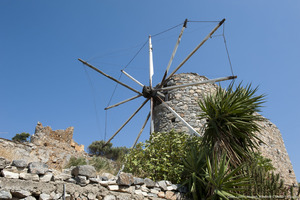 Away from the crowds in Knossos, Crete is still very rural. There are orchards and olives, roaming flocks of sheep and herds of goats, their bells clanging, and fields full of vegetables and herbs. The Lasithi Plateau is particularly fertile, and its crops are irrigated by a unique system of white cloth-sailed windmills that draw water up from wells in the summer. It’s one of Crete’s unique sites.
Away from the crowds in Knossos, Crete is still very rural. There are orchards and olives, roaming flocks of sheep and herds of goats, their bells clanging, and fields full of vegetables and herbs. The Lasithi Plateau is particularly fertile, and its crops are irrigated by a unique system of white cloth-sailed windmills that draw water up from wells in the summer. It’s one of Crete’s unique sites.
On our way – up a very twisty road at times – we stopped off for a cup of mountain tea. This is the traditional herbal tea you will find in every village, served with pastries oozing honey. At Moutsounos Cafe we found not just tea and pastries but the owner’s olive wood carvings – an art he learned from his grandfather who died aged 107. Must be something in the mountain air.
But Crete is, of course, an island and it’s as much about the coast as it is the mountains. Rather than stay in the capital Heraklion or one of the other big towns on the north coast, I went around the corner to the east coast where there are some spectacular beaches, dramatic cliffs and pretty coves. 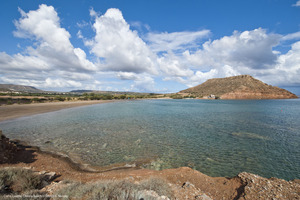 I opted for one of these, Daios Cove, where there is an exceptionally good hotel of the same name – as it has the whole horseshoe-shaped cove to itself. So it has its own beach plus a variety of pools (including a heated seawater one) and nearly all the rooms have a plunge pool and deck of their own.
I opted for one of these, Daios Cove, where there is an exceptionally good hotel of the same name – as it has the whole horseshoe-shaped cove to itself. So it has its own beach plus a variety of pools (including a heated seawater one) and nearly all the rooms have a plunge pool and deck of their own.
Built on to the cliff side and overlooking dark blue and turquoise waters, this is a super-relaxing resort. There’s a spa, several restaurants including Taverna (Greek with a modern twist), Ocean with superb cooking and the emphasis on fish and a beach bar with such seaside delights as fresh grilled sardines. All the rooms and restaurants have great views of the sea and – just to emphasise that this amazing spot is what it’s all about – there’s a glass ‘funicular’ that takes you up and down the mountain from the beach to the restaurants to your room so you get to see that sea from all floors. Breathtaking.
You really can’t get enough of Crete, so next I’m off to the other end of the island, the almost undiscovered western shore.
Nightly rates at Daios Cove are from €230 (£202*) in a Deluxe Sea View Room on a half board basis. To book visit: daioscove.com or call +44 20 3807 1418. *Prices in pound sterling accurate as of today’s exchange rate.
Western Crete
If you’ve come to Crete to get away from it all – head west. The western end of the island is far less populated, more rural and has fewer visitors. If you’re after nightlife this is not the place for you. But if you want empty beaches, soaring eagles, green mountains and dramatic gorges, this is the place.
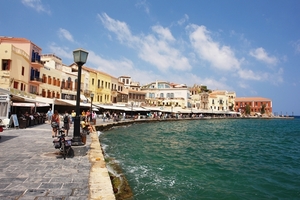 The main town here is Chania (or Hania or Xania!) and it’s indisputably the most beautiful town in Crete. It actually used to be the island’s capital though that honour passed to Heraklion a long time ago. It still wins hands down on charm, though. This is partly down to its complicated heritage. There are Minoan remains here but there are layers of Byzantine, Ottoman and Venetian architecture, too. The vast harbour was built by the Venetians and is now encircled by bars and tavernas, museums (pop into the Exhibition of Traditional Naval Architecture for a reconstructed 1500BC Minoan ship) and stalls. It shimmers in the heat as you watch the world go by over lunch and it’s just as attractive when lit up at night. Behind the harbour a web of maze-like streets fans out filled with crumbling cottages and elegant Venetian houses and there are plenty of sites, though it’s so pretty just walking through the town is a delight in itself.
The main town here is Chania (or Hania or Xania!) and it’s indisputably the most beautiful town in Crete. It actually used to be the island’s capital though that honour passed to Heraklion a long time ago. It still wins hands down on charm, though. This is partly down to its complicated heritage. There are Minoan remains here but there are layers of Byzantine, Ottoman and Venetian architecture, too. The vast harbour was built by the Venetians and is now encircled by bars and tavernas, museums (pop into the Exhibition of Traditional Naval Architecture for a reconstructed 1500BC Minoan ship) and stalls. It shimmers in the heat as you watch the world go by over lunch and it’s just as attractive when lit up at night. Behind the harbour a web of maze-like streets fans out filled with crumbling cottages and elegant Venetian houses and there are plenty of sites, though it’s so pretty just walking through the town is a delight in itself.
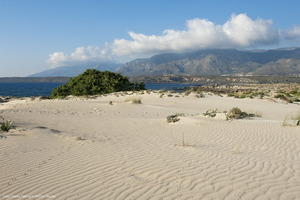 Beyond Chania, the further west you go, the quieter and more rural it gets. The coastline is very beautiful and often dramatic with some perfect beaches at the edge of the turquoise sea – Elafonisi and Falasarna being a case in point. There’s more to Falasarna than the beach, though. Ancient Falasarna was originally a Minoan settlement but what you see now is of a much later date, around the seventh century BC. It was a harbour but it has moved inland due to earthquakes over the centuries – this part of Crete is now thought to be 8m higher than in Minoan times.
Beyond Chania, the further west you go, the quieter and more rural it gets. The coastline is very beautiful and often dramatic with some perfect beaches at the edge of the turquoise sea – Elafonisi and Falasarna being a case in point. There’s more to Falasarna than the beach, though. Ancient Falasarna was originally a Minoan settlement but what you see now is of a much later date, around the seventh century BC. It was a harbour but it has moved inland due to earthquakes over the centuries – this part of Crete is now thought to be 8m higher than in Minoan times.
The locals will tell you – and no one can actually know this for sure – that this was the place where the Antikythera Mechanism was made, otherwise known as the world’s first computer. It was found in a shipwreck off the coast of the nearby island of Antikythera and was submerged for more than 2000 years. It was found at the turn of the 1900s by local divers and consisted of a series of bronze gears and wheels encased originally in wood. It is now thought that this was an orrery – built to predict the movements of the five planets known to the Greeks at the time as well as the sun and the moon, eclipses and quite possibly the schedule for the Olympic Games. It would seem to rely on the fact (some 1500 years before Copernicus and Galileo) that the sun was at the centre of the solar system. Quite simply, as the Smithsonian Institute in Washington summed it up: “Nothing as sophisticated, or even close, appears again for more than a thousand years.”
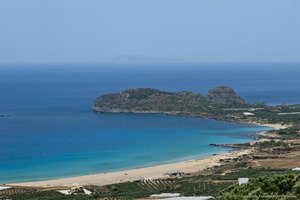 At the far end of Falasarna beach, there are fish tavernas with tables under the trees at the water’s edge. You’ll find them all along this section of the north coast, too, especially around the two harbours of Kissamos and besides that very fresh fish, there are plenty of other local specialities. Top of the list are olives and olive oil, of course, and every village makes its own. Crete was, apparently, the first place to domesticate bees and the local honey (pine or thyme depending on the bees’ elevation up the mountains) is particularly good. Local sheep and goat yoghurt and cheese can be found in every corner shop along with a wealth of picked-that-morning fruit and vegetables. It’s all very healthy and no doubt a contributory factor to Crete having one of the world’s longest lived and healthiest populations. Well, it’s either that or the ouzo.
At the far end of Falasarna beach, there are fish tavernas with tables under the trees at the water’s edge. You’ll find them all along this section of the north coast, too, especially around the two harbours of Kissamos and besides that very fresh fish, there are plenty of other local specialities. Top of the list are olives and olive oil, of course, and every village makes its own. Crete was, apparently, the first place to domesticate bees and the local honey (pine or thyme depending on the bees’ elevation up the mountains) is particularly good. Local sheep and goat yoghurt and cheese can be found in every corner shop along with a wealth of picked-that-morning fruit and vegetables. It’s all very healthy and no doubt a contributory factor to Crete having one of the world’s longest lived and healthiest populations. Well, it’s either that or the ouzo.
What you do get at this end of the island is an authentic, slower pace of life and perhaps that’s another factor in local longevity. As well as all that walking. Crete is a mountainous island, as I’ve already said, and the locals have always had to do a fair amount of uphill walking as a matter of course. 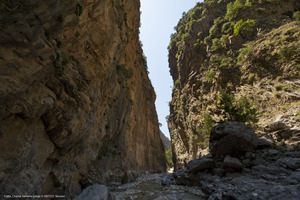 Visitors put on their hiking boots for pleasure, too, and one of Crete’s most famous walks is the Samaria gorge. It’s a dramatically beautiful place next to a river part of the way (good for soaking sore feet), and highlights include the abandoned village of Samaria, an ancient church and spectacular cliffs. It’s not, though, a hike for the faint hearted – it’s 17km long (Europe’s longest gorge) and quite difficult in places.
Visitors put on their hiking boots for pleasure, too, and one of Crete’s most famous walks is the Samaria gorge. It’s a dramatically beautiful place next to a river part of the way (good for soaking sore feet), and highlights include the abandoned village of Samaria, an ancient church and spectacular cliffs. It’s not, though, a hike for the faint hearted – it’s 17km long (Europe’s longest gorge) and quite difficult in places.
And a place to relax after all this? I stayed at Youphoria Villas overlooking Kissamos Bay and the Aegean and they certainly live up to their name. Described as “Cretan contemporary living” there are just eight of them positioned over the hillside for total privacy and exceptional comfort. Every luxury you can want (coffee machine, private pool, BBQ) is on hand along with a real elegance. The generous terraces with seating, dining and sunbathing areas are almost too difficult to leave and you can even get the villa manager to arrange deliveries of veggie boxes and meals from local restaurants.
This is such a tranquil spot. Not only are there the sea views, but you are surrounded by a positive forest of olive trees. The only sounds are the birds, the goats’ bells and the occasional chime of the bell in the chapel just up the hill.
Youphoria? You bet.
Youphoria have one, two and three-bedroom villas on the hillside above Kissamos Bay available from 300 euros per night. They also have very spacious and private beachfront villas from 500 euros.
For holidays to Crete Silver Travel Advisor recommends Simpson Travel.
Images copyright © Y Skoulas and © GNTO



